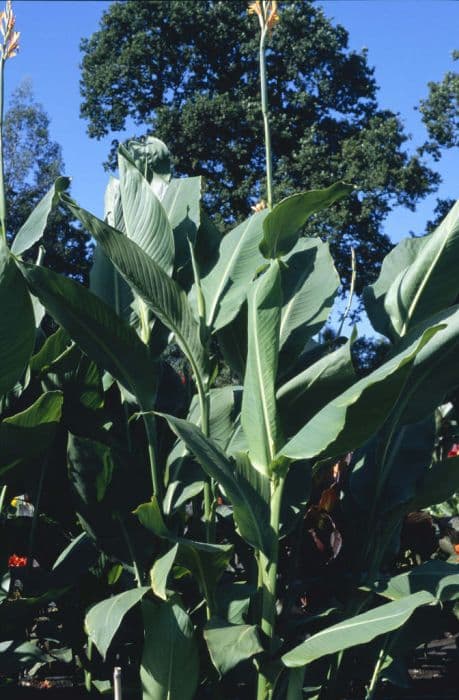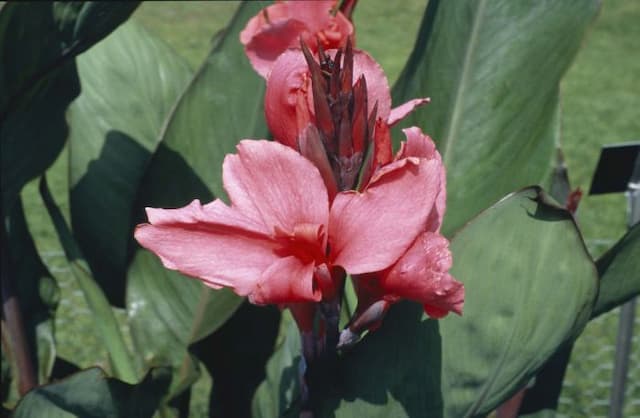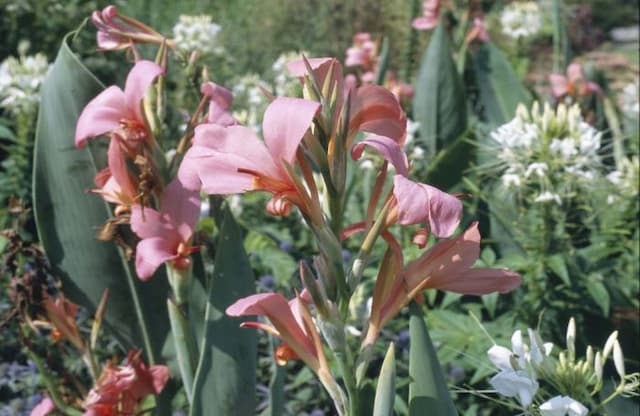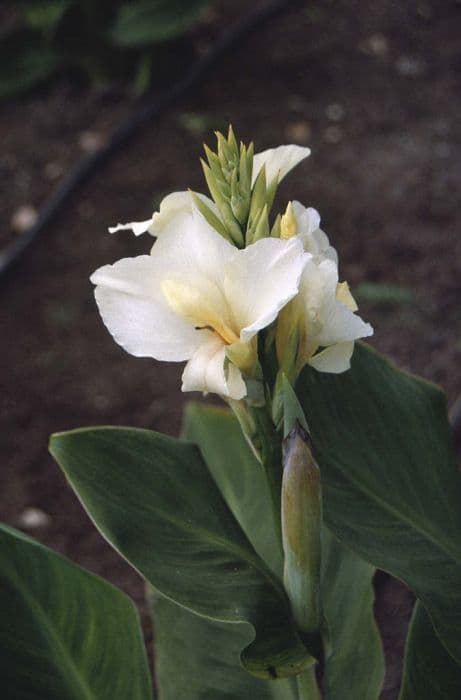Indian Shot Canna indica 'Purpurea'

ABOUT
The canna lily 'Purpurea', known for its striking presence in the garden, boasts a bold appearance. Its foliage is what sets it apart, with leaves that are a deep burgundy-purple color, creating a dramatic backdrop for the vibrant flowers it produces. The leaves are broad and large, with a texture that can appear waxy, and they can sometimes have a slight blue-green sheen at certain angles. Flowering from spring to fall, this plant sports blooms that are typically a bright orange or red, providing a stark contrast to the dark foliage. The flowers have a somewhat tropical look and are iris-like in shape, with flared petals that attract hummingbirds and butterflies. As a tropical plant, it adds an exotic touch to any setting where it is used, whether it be a flower border or a container garden. Overall, the canna lily 'Purpurea' is admired for its rich color palette and aesthetic contribution it brings to landscaping designs, but specifics about the plant's size are not highlighted in this description.
About this plant
 Names
NamesFamily
Cannaceae
Synonyms
Indian Shot, African Arrowroot, Purple Canna, Purple-leaf Canna
Common names
Canna edulis, Canna edulis var. rubra, Canna ehrenbergii, Canna indica var. edulis, Canna indica var. rubra, Canna indica var. sanctae-rosae, Canna lutea, Canna lutea var. rubra, Canna purpurea, Xyphostylis lutea.
 Toxicity
ToxicityTo humans
The plant commonly known as Indian Shot is not considered toxic to humans. There are no significant reports of poisoning from ingestion. Therefore, it is generally regarded as safe with respect to human toxicity.
To pets
Indian Shot is also not considered toxic to pets. It is not known to cause any significant toxic effects or symptoms of poisoning if pets ingest parts of the plant. Thus, it is usually considered safe for pets as well. However, ingestion of any plant material can potentially cause mild stomach upset in some animals, so it is always wise to prevent pets from eating plants unnecessarily.
 Characteristics
CharacteristicsLife cycle
Perennials
Foliage type
Deciduous
Color of leaves
Green
Flower color
Red
Height
3-5 feet (0.91-1.52 meters)
Spread
2-3 feet (0.61-0.91 meters)
Plant type
Herb
Hardiness zones
8-11
Native area
South America
Benefits
 General Benefits
General Benefits- Ornamental value: Canna indica 'Purpurea', commonly known as Indian Shot, adds aesthetic appeal to gardens with its striking purple to burgundy foliage and vibrant flowers.
- Easy to grow: It is a low-maintenance plant that can thrive in a variety of soil types and requires minimal care once established.
- Drought resistance: Indian Shot has a good tolerance for dry conditions once it is established, making it suitable for xeriscaping or areas with water restrictions.
- Rapid growth: The plant has a fast growth rate, which allows for quick filling of garden spaces and creation of visual impact.
- Attracts pollinators: The bright flowers of Indian Shot attract bees, butterflies, and hummingbirds, supporting biodiversity and pollination in the garden.
- Versatility in landscaping: Indian Shot can be used in a variety of garden styles, including tropical, contemporary, and cottage gardens, and can be grown in beds, borders, or containers.
- Season-long bloom: The plant flowers from late spring until frost, providing a long season of interest in the garden.
- Tolerant of wet soils: Indian Shot can tolerate wet soil conditions, making it suitable for planting in areas that may not drain well or near water features.
- Edible rhizomes: The rhizomes of Indian Shot can be harvested and used as a source of starch in culinary uses, although it is not its main function in ornamental gardening.
 Medical Properties
Medical Properties- Antidiabetic: Some compounds in Canna indica 'Purpurea' may have blood glucose-lowering effects.
- Antimicrobial: There are indications that extracts from Canna indica 'Purpurea' have properties that could inhibit the growth of certain bacteria and fungi.
- Anti-inflammatory: Components in the plant may possess anti-inflammatory properties, potentially reducing inflammation.
 Air-purifying Qualities
Air-purifying QualitiesThis plant is not specifically known for air purifying qualities.
 Other Uses
Other Uses- As a source of starch: The rhizomes of Canna indica (Canna Lily) are rich in starch, which can be extracted and used as a gluten-free flour alternative.
- In papermaking: The fibrous stems of the Canna Lily can be pulped and used in the production of paper.
- For crafting natural dyes: The leaves and flowers of Canna Lily can be used to create natural dyes for coloring fabrics and other materials.
- As livestock fodder: The foliage of Canna Lily can be used as feed for livestock as part of a mixed diet.
- In biofuel production: The biomass from Canna Lily can be used for producing bioethanol, serving as an alternative energy source.
- For erosion control: Planting Canna Lily along the banks of waterways can help stabilize the soil and control erosion.
- As a living mulch: The dense growth of Canna Lily can suppress weeds and help maintain soil moisture when used as ground cover.
- In aquascaping: Canna Lily can be used in water gardens and ponds for ornamental purposes, adding vertical interest and texture.
- For plant breeding: Hybridizers can use the Canna Lily as a parent in crossbreeding to create new ornamental varieties.
- As an educational tool: Canna Lily can be used in schools or community gardens to teach principles of botany and plant care.
Interesting Facts
 Feng Shui
Feng ShuiThe Canna Lily is not used in Feng Shui practice.
 Zodiac Sign Compitability
Zodiac Sign CompitabilityThe Canna Lily is not used in astrology practice.
 Plant Symbolism
Plant Symbolism- Love & Attraction: Canna indica 'Purpurea', commonly known as Indian Shot, often represents love and attraction due to its vivid flowers which can symbolize the intensity and passion in relationships.
- Prosperity: The lush foliage and rapid growth of the Indian Shot symbolize prosperity and abundance, making it a popular plant in gardens to attract wealth.
- Beauty: With its striking purple leaves and attractive blooms, the Indian Shot is emblematic of beauty and is often used in ornamental displays to add aesthetic appeal.
- Change and Transition: The Indian Shot's growth cycle, from rhizome to bloom, can symbolize change and transformation, representing the beauty of personal growth and transition.
 Water
WaterTropicanna Canna (Canna indica 'Purpurea') prefers consistently moist soil and should be watered thoroughly once the top inch of soil starts to dry out, which generally means watering about once a week. The method involves watering directly at the base of the plant, ensuring that the water penetrates deeply into the soil to encourage strong root growth. During hot weather or when the plant is in full sun, it may require more frequent watering. Provide about 1 gallon of water per plant for each watering session, adjusting as necessary for your climate.
 Light
LightTropicanna Canna thrives in full sun, meaning it should receive at least 6 to 8 hours of direct sunlight daily. The ideal spot for this plant is in an area where it can bask in the morning sun and be protected from the harsh afternoon light if you are in a very hot climate. They are adaptable, however, and can also tolerate partial shade, especially in the hottest parts of the day.
 Temperature
TemperatureTropicanna Canna prefers warm climates and does best in temperatures ranging from 60°F to about 90°F. It can survive minimum temperatures of down to around 50°F for short periods, but frost can be detrimental. The ideal temperature condition to promote growth and flowering is between 70°F and 85°F.
 Pruning
PruningPrune Tropicanna Canna to remove spent flowers and to shape the plant, as well as to encourage more blooms. Cut back old flower stalks to the base after flowering. Pruning is also necessary to remove any winter-damaged foliage at the beginning of the growing season. The best time for pruning is late winter or early spring, before new growth begins.
 Cleaning
CleaningAs needed
 Soil
SoilCanna Lily 'Purpurea' thrives in a well-draining, rich, loamy soil with a pH range of 6.0 to 6.5. A mixture of two parts loam, one part peat, and one part perlite or sand is ideal for ensuring proper drainage and fertility.
 Repotting
RepottingCanna Lily 'Purpurea' should generally be repotted every 2 to 3 years to refresh the soil and to accommodate the rapid growth of the plant.
 Humidity & Misting
Humidity & MistingCanna Lily 'Purpurea' prefers high humidity but is quite adaptable and can tolerate a wide range of humidity levels as long as it is well-watered.
 Suitable locations
Suitable locationsIndoor
Provide bright light, rich soil, and keep the soil moist.
Outdoor
Plant in full sun, enrich soil, ensure space for growth.
Hardiness zone
7-11 USDA
 Life cycle
Life cycleCanna indica 'Purpurea', commonly known as Purple-leaved Indian Shot, begins its life cycle when a rhizome, or underground stem, sprouts and sends up shoots. These shoots emerge as leaves that unfurl to showcase the plant's distinctive purple to bronze coloring. As the plant matures, it develops tall stalks that bear vibrant flowers, typically in shades of red, orange, or yellow, which can attract pollinators such as bees and hummingbirds. After pollination, the flowers develop into seed pods that round out the life cycle when they dry and release seeds, capable of growing into new plants. In regions with colder climates, the Purple-leaved Indian Shot's rhizomes can be overwintered indoors to protect them from frost, ensuring they survive to sprout again in the spring. Throughout its life cycle, this perennial can be divided and transplanted to propagate and spread in the garden.
 Propogation
PropogationPropogation time
Spring-Early Summer
Propogation: The Canna Lily 'Purpurea', known for its vibrant foliage and flowers, is most commonly propagated through division, typically carried out in the spring. To propagate by division, carefully dig up the rhizomes, which are the horizontal underground stems, after the plant has finished flowering or when new growth begins. Once the rhizomes are unearthed, use a sharp, clean knife to cut them into sections, ensuring that each section contains at least one eye, which is a growth point. It's important to treat the cut sections with a fungicide to prevent disease. After that, plant the rhizome sections about 4 inches (10 centimeters) deep into well-draining soil, spacing each piece about 18 to 24 inches (45 to 60 centimeters) apart to give them room to grow. The rhizomes will give rise to new plants that will eventually mature and flower, thus continuing the spread of these striking ornamentals in your garden.









